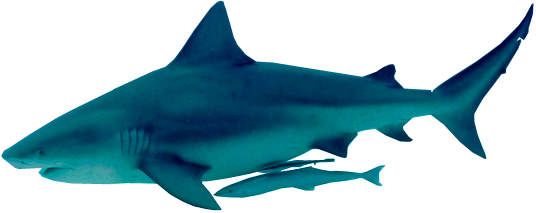
Bull Shark
Carcharhinus leucas
Lifespan: 16 years
Size: 7-11.5 ft (2.1-3.5 m) Females are slightly larger
Weight: around 6 tons (5,400 kg) (90 to 225 kg)
Conservation Status: Near Threatened
Gestation: 12 months
Found In: Coastal Waters and Rivers Worldwide
Group: School or Shoal
Other Names: Zambezi Shark, Zambi, Nicaragua Shark
Anatomy: Bull Sharks are large, stout sharks. At birth, bull sharks measure around 2.5 feet (0.8 m). Females are usually slightly larger than males, averaging 7.9 feet (2.4 m) and
7.4 feet (2.3 m) respectively. Females weigh in at an average 290 (130 kg) pounds, compared to the 210 (95 kg) pound average of males. The heaviest shark
ever recorded was 694 pounds and there was a questionable sighting of 13 foot (4 m) female - the largest ever.
Buoyancy: Unlike fish, sharks don't have swim bladders. Instead, they have many adaptations that allow them to
habit many different
depth ranges. One of these is the fact that they have a very large amount of oil in their liver,
which has a lower density than water, thus
allowing them to raise in the water column. They also have large pectoral fins
which, much like those of an airplane in the air, provide lift in the water. Lastly, their skeletal system is made of
cartilage. Cartilage is much lighter than bone, which would drag them down.
Habitat: The bull shark lives in warm, coastal waters around the world. Because of their ability to osmoregulate, they have
been seen in rivers and lakes around the world. In the Mississippi, they have been found as far north as Illinois. They have been
known to swim as deep as 490 feet (150 meters), but rarely go below 100 feet (30 meters).
Osmoregulation: Bull sharks are the only shark that can osmoregulate. This is the process by which a fish can change to way its
kidneys work in order to survive in both freshwater and saltwater.
Reproduction: Mating usually occurs during late summer and early autumn, and often occurs in the mouths of rivers. They have
a gestation period of 12 months. Litters usually number from 4 to 10 pups. They are vivaporous. They pups are around 28 inches (70 cm)
and they generally spend there first years of life in lagoons, river mouths, and other places with a great amount of protection. These
sharks are able to reproduce at an age of 15 years for males and 18 years for females.
Interesting Facts: Bull Sharks have the highest bite force of any cartilaginous fish: 1,300 lbf (600 kgf).

